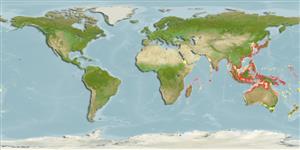Environment: milieu / climate zone / depth range / distribution range
Écologie
marin; saumâtre récifal; profondeur 5 - 40 m (Ref. 90102). Tropical
Western Pacific: Gulf of Thailand to southern Japan, Philippines (Ref. 9494), Borneo and Indonesia. Absent from New Guinea and Australia.
Taille / Poids / Âge
Maturity: Lm ? range ? - ? cm
Max length : 26.0 cm TL mâle / non sexé; (Ref. 90102); common length : 16.0 cm TL mâle / non sexé; (Ref. 9893); poids max. publié: 168.50 g (Ref. 124479)
Rayons mous dorsaux (Total) : 74 - 78; Rayons mous anaux: 65 - 68; Vertèbres: 51 - 52.
Inhabits shallow sand and mud bottoms of coastal waters. Feeds mainly on benthic invertebrates, especially small crustaceans. Marketed fresh, frozen, and dried-salted.
Life cycle and mating behavior
Maturité | Reproduction | Frai | Œufs | Fécondité | Larves
Munroe, T.A., 2001. Soleidae. Soles. p. 3878-3889. In K.E. Carpenter and V. Niem (eds.) FAO species identification guide for fishery purposes. The living marine resources of the Western Central Pacific. Vol. 6. Bony fishes part 4 (Labridae to Latimeriidae), estuarine crocodiles. FAO, Rome. (Ref. 9893)
Statut dans la liste rouge de l'IUCN (Ref. 130435: Version 2024-1)
Menace pour l'homme
Harmless
Utilisations par l'homme
Pêcheries: commercial
Outils
Articles particuliers
Télécharger en XML
Sources Internet
Estimates based on models
Preferred temperature (Ref.
123201): 21.3 - 29.1, mean 28.3 °C (based on 882 cells).
Phylogenetic diversity index (Ref.
82804): PD
50 = 0.5000 [Uniqueness, from 0.5 = low to 2.0 = high].
Bayesian length-weight: a=0.00794 (0.00492 - 0.01282), b=3.10 (2.96 - 3.24), in cm total length, based on LWR estimates for this species & (Sub)family-body (Ref.
93245).
Niveau trophique (Ref.
69278): 3.5 ±0.50 se; based on food items.
Résilience (Ref.
120179): Milieu, temps minimum de doublement de population : 1,4 à 4,4 années (Preliminary K or Fecundity.).
Fishing Vulnerability (Ref.
59153): Low vulnerability (16 of 100).
